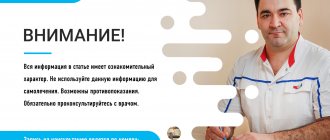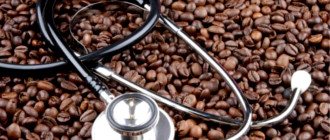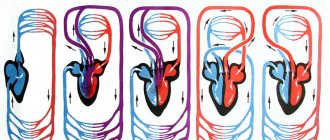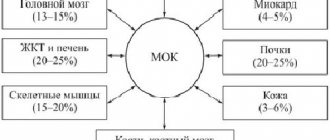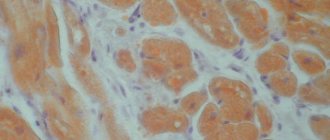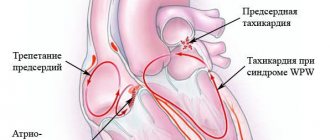- 19 September 2021 12:09
| Quantity |
Heart attack is one of the leading causes of death worldwide, which could have been avoided if people had been able to recognize a heart attack in time and seek medical help. Every person should know the main signs of a heart attack, in the event of which it is necessary to urgently call an ambulance in order to save the life of yourself or your neighbor.
What is a heart attack and what do you need to know about it?
To pump blood, the heart constantly needs oxygen and nutrients. The two large coronary arteries supply oxygenated blood to the heart muscle. If one of these arteries or their branches suddenly becomes blocked, a certain part of the heart becomes starved of oxygen. This phenomenon is called cardiac ischemia.
In the case of prolonged cardiac ischemia, tissue that does not receive oxygen dies, which is actually called a heart attack, myocardial infarction, or, literally speaking, the death of the heart muscle.
Most heart attacks last for several hours, so don't wait to seek help if you suspect a heart attack. In some cases, heart attack symptoms may not appear at all, but most heart attacks cause chest pain. Other signs of a heart attack include:
- difficulty breathing;
- dizziness;
- fainting;
- nausea.
The pain that occurs during a heart attack can be compared to a feeling of compression of the heart. The pain may be constant or intermittent. It is also worth noting that the signs of a heart attack in women and men may be different.
The main signs of a heart attack in women and men
1. Chest discomfort - most heart attacks are accompanied by a feeling of discomfort in the central part of the chest that does not go away within a few minutes (pressure, squeezing or pain). 2. Discomfort in other areas of the upper body - pain or discomfort in one or both arms, back, neck, jaw or stomach. 3. Difficulty breathing (whether accompanied by a feeling of discomfort or not). 4. Cold sweat, nausea or dizziness.
The main sign of a heart attack in both men and women is pain or discomfort in the chest. However, women are more likely than men to experience other signs of a heart attack: difficulty breathing, nausea/vomiting, and back or jaw pain.
What is the difference between angina and myocardial infarction?
Most heart attack victims do not notice the warning signs of impending danger, which manifest themselves in the form of angina pectoris - chest pain, which is also caused by ischemia. The difference between angina and a heart attack is that with angina, blood flow is quickly restored, the pain goes away within minutes, and there is no permanent damage to the heart. During a heart attack, the blood flow is significantly reduced or completely blocked, the pain is constant, and without proper medical intervention, the heart muscle dies.
About 25% of all heart attacks occur suddenly, i.e. without previous symptoms. Sometimes they are associated with a phenomenon called “silent” ischemia - random interruptions in blood flow to the heart, which for unknown reasons are not accompanied by pain, although they can lead to damage to heart tissue. Silent ischemia is often observed in diabetic patients.
The patient is discharged from the hospital and changes the prescribed treatment
If everything goes well, the patient is taken to the vascular center, where he undergoes a coronary intervention procedure: a stent is placed in the damaged vessel and blood flow is restored. After treatment in a hospital, the patient receives prescriptions and is sent under the supervision of his district clinic. Where very often his prescribed treatment is changed.
Sometimes this happens on the initiative of the patient.
“Patients today are not the same as they were 20-30 years ago,” Simon Matskeplishvili shares his observations. “They come having already read everything about their diagnosis, they know in advance what complications they will have, side effects from the drugs that we prescribe for them, and they begin to choose: “I don’t want to take this drug, I want this one.”
Replacing an expensive drug with a cheaper or free one - from a limited set that exists in the clinic - is also a very common occurrence . Sometimes this decision is pushed by a clinic doctor, sometimes by a pharmacy employee.
“Ideally, patients should continue to be treated in the same place where they began to be treated,” Dr. Matskeplishvili is sure. — All hospitals have consultative and diagnostic centers for this purpose; you can get there using a compulsory medical insurance policy. We have every opportunity to save the patient’s life in the acute period and avoid the need for re-hospitalization - but only with continuity of treatment and fulfillment of our prescriptions.
Life-threatening dangers and complications of myocardial infarction
Death before arrival at the hospital occurs in 25% of people with a heart attack; the remaining 75% are at risk of complications after a heart attack, which are:
- stroke;
- arrhythmia;
- heart failure;
- blood clots in the legs or heart;
- aneurysm.
It is worth noting that people who survive a heart attack without complications a few hours after the heart attack have a high chance of making a full recovery.
Recovery from a heart attack is always a difficult process, since any heart attack weakens the heart to a greater or lesser extent. Depending on the severity of the heart attack, further scarring of the heart, and the speed of medical care, a heart attack can lead to:
- heart failure, in which the heart cannot pump blood properly;
- arrhythmias or abnormal heart rhythms;
- cardiac arrest or sudden cardiac death (heart stops beating);
- cardiogenic shock (in which the heart is so damaged that the person is in shock);
- of death.
If a patient has a stent placed...
...taking medications is a vital necessity for him. Stent placement requires mandatory use of dual antiplatelet therapy.
“If we placed a stent, and the patient, for some reason, stopped taking the medications, this is a 100% death of the patient!” - Maria Glezer emphasizes. “The patient often thinks: “They put a stent in me, now my blood will flow like through a pipe.” Yes, the blood will flow like through a pipe. But the pipe must be open. If it closes, everything will end very badly. And “keeping the pipe open” is precisely blood thinning drugs.
Dr. Glaeser is convinced that even before a patient undergoes an intervention with a stent installed, it is necessary to inform him about the need to take dual antiplatelet therapy. If for some reason the patient is not ready for this, it makes sense to choose other treatment methods.
Advertising
Prevention of myocardial infarction in men and women
The main risk factor for myocardial infarction is coronary heart disease.
You can reduce the risk of heart disease and a heart attack in the following ways: 1. Quit smoking. 2. Monitor your blood pressure. Remember that people with high blood pressure (hypertension) have an increased risk of heart attack and heart disease. 3. Monitor your blood sugar levels. Diabetes carries a risk of developing heart disease. 4. Monitor your blood cholesterol levels. If you don't know what your cholesterol level is, it's time to get tested. 5. Watch your weight. Obese people are known to be at greater risk of dying from heart disease than people of normal weight. 6. Be active. It has been found that regular physical activity is an excellent way to prevent heart attacks and other heart diseases. 7. Eat right. More fruits, vegetables and omega-3 acids. Remember that to select the right diet, you need to consult a specialist, since your body is unique. 8. Don't get stressed. Learn to manage stress, such as through yoga or meditation. 9. Communicate. The social support you receive from family and friends is an excellent way to prevent heart attacks and many diseases. 10. Learn to manage your anger. Do not suppress anger, but direct it in the right direction, give the right outlet to emotions. Be vigilant, do not ignore the dangerous signs of a heart attack! Remember that timely assistance is the only way to survive a heart attack! Cardiologist Liliya Avkhatovna Yapparova
Many people imagine why a heart is needed. Heartless people rarely enjoy authority in the team. They say that you can imprint the image of a loved one in your heart. A cheerful song makes it easy on him (the heart), but when the song is about to be sung, he (the heart) can sense evil in advance. For example, an impending myocardial infarction . In essence, the heart is a very simple organ. Unlike the folklore hero, who knows how to both dig and not dig, the heart does not even have such a simple choice. The heart can only pump blood. The contractions follow one another completely automatically and almost independently of brain signals. A healthy heart, warmed up to body temperature and filled with blood, will begin to pump it no matter what happens around it. And this is very good: the fewer adjustment knobs, the more reliable the device.
This is probably why it is somehow not customary to pay attention to the most important muscle of the body. All sorts of approaches and repetitions are often performed for the sake of little-needed biceps and abs on the stomach.
Most people know three things about myocardial infarction:
1 - It hurts somewhere in the chest.
2 - This won’t happen to me for another twenty, thirty or fifty years.
3 – It won’t take long to die from this.
So what is myocardial infarction? It must be said right away that this is not a heart rupture, as is commonly believed, although in some cases this can occur as a complication.
A heart attack is a disease in which there is a complete cessation of blood supply to one of the arteries supplying the heart, as a result of which the corresponding section of the heart muscle dies. For the development of myocardial infarction, complete closure of the artery within 15-30 minutes is sufficient. The death of myocardial cells is accompanied by severe pain.
The main classic symptom of myocardial infarction is pressing or burning severe pain behind the sternum, which can radiate (radiate) under the left shoulder blade, into the left arm or lower jaw. Many patients with a heart attack develop cold sweat, the skin takes on a pale gray color, they feel weak and dizzy, shortness of breath and increased heart rate. The pain during a heart attack is severe and prolonged, and attacks last for 10-15 minutes. You cannot try to endure the pain; in case of a heart attack, any delay is dangerous. Therefore, it is urgent to call an ambulance. In addition to chest pain, an alarming symptom is the fear of death.
Fear of death in general is a symptom that has been described for quite a long time, and the point here is that heart pain is not toothache or pain as a result of injury, but pain that appears in the mind as a harbinger of death. One of the doctors of past centuries generally spoke of angina as a “rehearsal for death.”
Below are photographs of people having a heart attack and a typical hand gesture for chest pain.
Let's figure out what are the causes of myocardial infarction or why does it occur? As already mentioned, myocardial infarction occurs due to an acute lack of oxygen in the heart muscle. This can happen under the following conditions.
1. The gradual growth of atherosclerotic plaques leads to the gradual closure of the artery; this process can develop over years or even decades. As a rule, this process is accompanied by symptoms of angina pectoris. At some point, the closure reaches critical levels and a disaster develops.
2. Arterial thrombosis. This scenario is also not developing out of the blue. Arterial thrombosis occurs when the surface of the so-called tire or plaque ruptures. The plaque itself may be small in size and not manifest itself in any way. When a plaque ruptures or tears, a surface is exposed, which, like a magnet, attracts platelets, which in turn, combining with red blood cells, form a blood clot, with subsequent cessation of blood supply.
3. Prolonged arterial spasm is less likely. Although, under stress, adrenaline is released into the blood, causing vasospasm, and causing the heart to beat like a jackhammer. As a result, the heart experiences oxygen starvation.
If the cause of a heart attack is thrombosis of the artery supplying the heart. In this case, the atherosclerotic plaque on which the blood clot has formed may be minimal in size and not affect the blood flow in any way. Therefore, by eliminating the thrombus, the patency of the vessel is completely restored. Thrombolysis helps solve this problem. However, it must be carried out while the thrombus is still fresh, that is, within 6 hours from the onset of a heart attack, then it is most effective and allows you to save most of the heart muscle.
Thrombolytics are drugs that have the ability to dissolve blood clots; they are administered intravenously at a strictly prescribed rate. This is done by the ambulance and the hospital emergency department. There is no need to delay calling the ambulance; time counts by minutes.
Currently, the most effective means of treating a heart attack is life-saving percutaneous coronary intervention: both abroad and in our country, treatment of myocardial infarction is increasingly carried out using interventional technologies - that is, already in the acute period, coronary angiography is performed, the infarct-related artery is detected and stented. or at least temporarily dilate with a special balloon. This procedure is called life-saving percutaneous coronary intervention (PCI) , as it is performed immediately upon the patient’s admission to the hospital, without waiting for the effect of therapy, or when other methods have already been exhausted.
None of the drugs can restore blood flow in the affected artery as well as mechanically eliminating this problem. However, due to the lack of expensive equipment, clinics where such treatment can be performed are not available everywhere. But in our region this opportunity exists. At any time of the day, patients are urgently delivered to the cardiac center in Surgut by air ambulance.
Coronary artery stenting is one of the most important advances in cardiology. The first stent placement in a cardiac artery was performed in 1986. Currently, coronary artery stenting has become an almost outpatient procedure. This is also called “one day surgery.”
Let's remember the popular song:
“If there is a break in the heart,
And you don't know what's wrong with you,
If there is blood beating in the heart,
So to you...
I've had a heart attack!"
What to do?
In fact, you can actually die from a heart attack. But it is much more attractive to stay alive and recover. The chances of such an outcome will increase greatly if you remember the sequence of five actions .
1 - Call 03
Once you understand the symptoms and understand what is happening to you, it is not recommended to waste time. Moreover, you should not be afraid that your authority will fall in the eyes of the rushing doctors if suddenly (God forbid, of course) instead of the expected heart attack you are diagnosed with sciatica. The extent of the lesion, the outcome of the disease and possible complications depend on how many minutes pass from the onset of the attack to first medical aid.
2 - Take aspirin
Aspirin, our native acetylsalicylic acid, is good not only for reducing fever or relieving headaches. In addition to the above effects, acetylsalicylic acid has one more - it quickly thins the blood, facilitating its passage through the narrowed area of the vessel, and reduces the likelihood of blood clot formation.
3 - Riffle through your first aid kit
Better yet, ask others to do it. You need nitroglycerin. This is something that can completely stop an angina attack or at least alleviate it until the doctors arrive. Nitroglycerin (or its analogues starting with “nitro-”) can be found in the pockets of elderly people and in the first aid kits of cars that have been honestly inspected. If you can’t find it, look for validol. No luck again - look in your pockets. Peppermint gum may also help. Menthol will cause the blood vessels of the heart to dilate.
4 - Sit down
The most advantageous body position is sitting with your legs down. You can lie down so that your chest and head are higher than your pelvis. This will make the work of the heart easier.
5 - Don't move
Remember that any movement is an extra strain on the heart. Try to calm down. You don't need extra adrenaline in your blood right now.
What not to do!
...However, we do not impose anything. It is quite possible that right now your heart attack coincided with your impulse to end your life. Then try the following.
- Wait. What if it goes away on its own? Then it will turn out stupid and undignified: a team of serious and busy doctors will arrive, and you are still alive. They will probably reproach you for this. But they will take you to the hospital anyway - a heart attack does not go away on its own, and besides, the logic of your reasoning clearly indicates that you need an eye and an eye.
- Drink coffee While waiting for the self-liquidation of a heart attack, you need to kill time somehow. Over a cup of coffee it will fly by unnoticed, and you won’t have much time. Soaking in a hot bath is an even more promising idea and, by the way, more popular (some people mistake a heart attack for muscle pain, which a hot bath could really relieve).
- Light a cigarette You have to somehow calm down while your fate is being decided and every molecule of oxygen counts. Relax in the best possible way. And fate will be decided much faster after smoking a cigarette.
- Run to the hospital or drive home from work. Urgently take your fate into your own hands, find out the geographical coordinates of the emergency department - and run. And it’s even better while driving: if you’re planning such an effective escape, why not take a couple of pedestrians with you? But if an ending in the spirit of an ancient tragedy is not part of your plans, don’t make unnecessary moves other than pressing two buttons on your phone. And it’s better to ask others about this if they don’t figure it out themselves.
- Treat with folk remedies Especially if this concept includes taking 50 ml of cognac, which supposedly helps in such cases.
Troubles associated with health never ask us when they will appear, but fall out of the blue and change a lot in our lives, if not everything, and in general, only they decide whether to leave us such a luxury - life? Life is a gift from God and throwing it into the furnace of social problems is truly not an affordable luxury.
You and I, day after day, lead a familiar and monotonous lifestyle.
In the morning, coffee, the road to work, a day like a squirrel in a wheel, in the evening on the way home an hour of attention to yourself, friends, shops, shopping, and family at home, worries, problems, repairs, loans, bills, debts and off we go...
And so on day after day, year after year throughout your life.
As a doctor, I am very familiar with the situation when a person plunges headlong into the abyss of everyday and personal problems, receives daily stress, which he lights up, drinks alcohol and eats junk food on the go, and when he stops, he only has the white ceiling of a hospital room before his eyes.
And then life tells us: That’s it, Stop, Finish – Heart attack!
And believe my medical experience, I deal with a heart attack every day, and no matter who you are by race, and no matter what social status you have, everyone is equal before a heart attack!
And when this happens, we begin to rewind the tape of events and beat ourselves in the chest with our fists or, biting our lips, let out tears, but understand more clearly than ever that all this could have been avoided.
I want to tell you with confidence that it is not possible, but necessary! Until it's not too late!
Myocardial infarction is a disease not only for those over 40. The determining factors here are not so much age as heredity and lifestyle. This means that it is better if no one in the family suffers from coronary heart disease, and you yourself do not drink, do not smoke and regularly go for a run. If all this is not about you, then it’s time to take care of your heart health, without putting it off until a critical age.
- Deal with smoking Not only does smoking increase the concentration of bad LDL cholesterol to the detriment of good HDL cholesterol. In addition, nicotine causes tachycardia, which increases the heart's oxygen consumption. At the same time, other components of tobacco smoke bind up to 10% of hemoglobin, reducing the flow of life-giving oxygen to starved cells. Therefore, it is not enough to quit smoking on your own. You will have to show violence to others. Passive smoking also increases the risk of heart attack.
- Get moving Physical inactivity – a sedentary lifestyle – is one of the factors contributing to the development of a heart attack. But just two hours of intense movement a week is enough to reduce the risk of illness by 10%. What exactly you will do all this time - run, jump or have sex - is up to you, but don’t be too philandering.
- Lose kilograms Lose weight to normal. The norm is approximately equal to your height minus a hundred. You can find out more precisely from your doctor. By reducing your weight to the desired figure, you will reduce the risk of atherosclerosis or at least slow down its progression. Besides, extra pounds mean extra millimeters of mercury in your blood vessels, and blood pressure is no joke. Get rid of everything unnecessary and you will get a head start of 3.6 years without a heart attack.
- Go on a drinking binge Only on condition - no alcohol! Replace it with a liter of plain H2O. This way you will definitely avoid dehydration. Not drinking enough fluid can make your blood thicker and therefore more prone to forming blood clots. Five glasses of water a day will dilute it and make it run more cheerfully through the vessels.
- Go fishing and catch more heart attack remedies there. Don't they bite? Go to the grocery store. There you can buy them for money in the fish department. The natives of the Far North eat only fish and do not suffer from heart disease. It's time to follow their example. However, two fish days a week will be enough for you. This way, you will increase the level of omega-3 fatty acids in your body, and this is the ingredient that makes fish the best way to prevent myocardial infarction.
- Have corn flakes for breakfast or buy boiled corn from your grandmothers. It is full of folic acid. The daily intake (about 400 micrograms) reduces the risk of heart attack by 13%. Folic acid reduces the blood level of the amino acid homocysteine, which negatively affects the condition of arterial walls.
- Don't boil Stress is a release of adrenaline, which means more intense work of the heart and an increased need for oxygen in its cells. All this increases the risk of a heart attack by 3 times. In order to develop a philosophical attitude towards life, the standard 10-second delay method is suitable. The point is simple. You need to count to 10 before reacting to a stimulus. Screaming and sputtering after such a long silence is already somehow stupid.
- Chew watermelons They have 40% more lycopene than the most famous source of this antioxidant - tomatoes. In addition, due to the high water content, watermelon lycopene is absorbed faster by the body. Now you are guaranteed another 30% confidence in your heart.
- Warn yourself Forewarned means forearmed, and since atherosclerosis and heart attack are diseases that have a genetic basis, there is a chance to arm yourself. Genetic analysis for predisposition to heart attack is a matter of the future (although perhaps not too distant). For now we will have to limit ourselves to studying the family tree. Just find out which of your relatives suffers from coronary heart disease. The closer the relationship, the greater the danger.
Recently, myocardial infarction has been rapidly getting younger. Nowadays it is not uncommon for it to strike people who have barely crossed the thirty-year threshold. MI (myocardial infarction) is a very common disease and is the most common cause of sudden death. The problem of heart attack has not been completely resolved, and mortality from it continues to increase. In the USA, about 500 thousand people, in France about 120 thousand suffer from large focal MI annually. Mortality from cardiovascular diseases in Russia tends to continuously increase, while in the countries of Western Europe, the USA, Canada, and Australia, over the past decades there has been a steady trend toward a decrease in mortality from IHD. Nowadays, myocardial infarction occurs more and more often at a young age. At the age of 35-50 years, MI occurs 50 times more often in men than in women. The peak incidence occurs between 50 and 70 years of age.
If you want to find out what condition your heart is in, you should undergo special examinations.
Comprehensive cardiac examination (heart examination)
1. An initial consultation with a cardiologist is carried out to collect a history of the patient’s life and previous diseases, so that after carrying out the planned examinations, the doctor can compare the results and have the most complete understanding of the identified problems, and then decide on further management tactics.
2. Laboratory examinations are carried out to assess the functioning of internal organs, as well as the general condition of the body, which allows a more objective assessment of the state of health of the body. A biochemical blood test allows you to assess the level of cardiac enzymes, and a lipid profile allows you to identify the levels of “good” and “bad” cholesterol, as well as the atherogenic coefficient, which allows you to assess the risk of cardiovascular complications. Thyroid hormones can affect your heart rate, so assessing your levels is essential.
3. ECG (electrocardiogram) is the simplest and most necessary method for assessing heart function. With its help, you can assess the heart rate, the state of the myocardial conduction system, identify focal changes in the myocardium, and also suspect many heart diseases.
4. An exercise ECG is performed to assess the heart’s resistance to physical stress. Sometimes, based on the results of this test, the issue of the need for coronary angiography is decided to assess the condition of the coronary vessels supplying the myocardium (heart muscle), which makes it possible to decide on the need for surgical treatment - angioplasty (implantation of stents) or coronary artery bypass grafting (CABG).
5. Daily monitoring of ECG and blood pressure (BP) allows you to evaluate these indicators at different periods of time when the patient leads his usual lifestyle during the day, as well as at night. It is possible to use these two methods simultaneously, which makes it possible to compare ECG changes depending on blood pressure, changes in blood pressure from the ECG and whether they depend on each other in each specific case.
6. Using EchoCG (echocardiography), the volumes of all chambers of the heart, valve apparatus, ejection fraction, systolic and diastolic function and other objective indicators of heart function are assessed.
7. Duplex scanning of neck vessels must be assessed to identify atherosclerotic plaques that narrow the lumen of blood vessels, which can lead to impaired delivery of blood, and therefore oxygen, to the brain, especially against the background of their increased tortuosity and changes in blood pressure (hypertension).
8. An ultrasound of the thyroid gland is performed to assess its condition and compare it with the level of its hormones. If violations are detected, consultation with an endocrinologist will be required. The condition of the thyroid gland directly affects the functioning of the heart.
9. Ultrasound of the abdominal organs is performed to assess the condition of the kidneys, renal vessels and adrenal glands, because disturbances in this area can lead to cardiac problems (eg, hypertension).
10. Based on the results of the examination, the doctor analyzes the results obtained and makes appropriate recommendations for further management tactics.
Quantity


